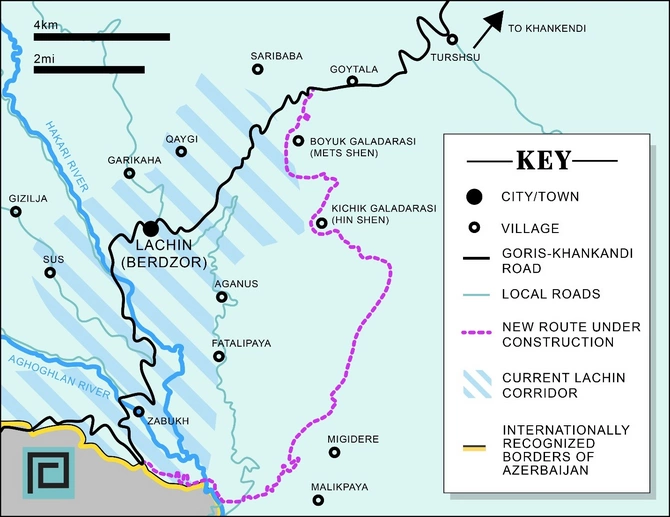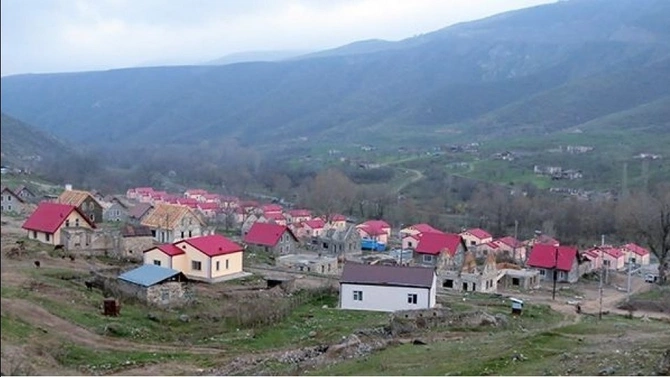
Zabukh – known by Armenians as Aghavno - is one village that will revert to #Azerbaijani control in 2023. Will its residents decide to stay once the families of original residents move back home?
Days after the end of the 2nd Karabakh War, on November 13, 2020, armoured personnel carriers of the Russian peacekeeping forces drive along a road in a settlement near Lachin in Karabakh. Image: REUTERS/Stringer
The ‘Lachin Corridor’ is a geopolitically sensitive strip of land between Armenia and the area of Azerbaijan where Russian peacekeepers are currently stationed. The corridor’s route is due to change next year, creating important logistical knock-ons for several communities.
In the Soviet era, Armenians living within Azerbaijan’s Nagorno Karabakh Autonomous Oblast (NKAO) had a certain degree of autonomy. In some places, the NKAO was not far from the eastern edge of the Armenian SSR (today’s Armenia), but the two entities had no common border. Between 1923 and 1930, the strip of Azerbaijani territory that divided the two was part of a Soviet experiment aimed at attracting Kurdish refugees - so-called “Red Kurdistan” with a capital officially called Abdallar according to maps of the era. However, in 1930 Stalin reversed his pro-Kurdish policies, and many of the region’s Kurds were deported to Central Asia. Abdallar was renamed Lachin, a name that locals had already been using, and became the administrative centre of an eponymous Lachin Region within Azerbaijan.
In the early 1990s, the Nagorno Karabakh Autonomous Oblast declared a never-recognized ‘independence’ and was essentially absorbed into Armenia. To make such a system work, Armenian forces invaded and depopulated the Lachin Region between the two entities to create a seamless connection. The strategically crucial part of this territory was surrounding a section of the Shusha-Goris road, an area that became known as the Lachin Corridor. Many other Azerbaijani lands were subsequently occupied. Still, in decades of international peace talks aimed at solving the Armenia-Azerbaijan conflict pre-2020, the status of the Lachin Corridor was always a particular sticking point.
Everything changed in 2020 when Azerbaijan reclaimed its occupied territories as a result of a 44-day war. Almost all lands were returned to Baku’s complete control, but part of the former NKAO was allowed to remain under Armenian administration with Russian peacekeepers in place. The agreement allowed Russia to patrol the Lachin Corridor as well, allowing Armenians easy access to Khankendi (known as Stepanakert in Armenian). For the tripartite agreement that ended the 2020 war, the corridor was defined as a 5km strip of territory surrounding the Shusha-Lachin-Goris road where it transits the Lachin Region. However, paragraph 6 of the tripartite agreement eventually envisaged the shifting of the 5km corridor to avoid inhabited settlements. Most specifically, this would allow the town of Lachin itself to fall entirely within Azerbaijani civilian control rather than lying, as it presently does, in the peculiar geopolitical no-mans-land of the existing Russian-patrolled corridor. These plans to shift the corridor were reiterated on December 1st, 2020, when Azerbaijan’s President Ilham Aliyev announced that the construction of a brand new Khankendi-Goris road would be completed within three years.
The issue then slipped out of the headlines, but the process of building such a road has been proceeding apace, a situation confirmed by a video


This map is the Caspian Post’s ‘best guess’ at the time of publishing, and is not intended to be authoritative.
The approximate route of the new road is fairly obvious from recent Google Earth images thanks to considerable earthworks produced. As yet, there seems to be little sign of corresponding work on the Armenian side of the border. The village of Kornidzor, in Armenia but just across the border river from where the new Lachin Corridor Bridge is being built, is likely to find itself better connected. Already in 2021, journalists found that residents had been getting on without incident with the Azerbaijani troops posted nearby.
The new route is planned to cut well south of the current road within Azerbaijan. This should prove helpful for around 80 Armenians who live in Kichik Galadarasi (formerly Kirov and now known to Armenians as Hin Shen), which will be on the new route. In 2021 some of the village residents claimed to feel intimidated by the installation of a nearby Azerbaijani military base, though their livelihood seems unaffected at large. 30 Armenian residents of Sus and around 175 in Zabukh (known to Armenians as Aghavno, or since September 2016 as Ariavan) may find themselves in an altogether more difficult situation once the corridor is diverted.

Zabukh – known to Armenians as Aghavno and rebuilt recently as ‘Ariavan’ – will revert to Azerbaijani control in 2023. Will its residents be happy/welcome to stay once the families of original residents reclaim their ancestral lands? Image: IkiSahil
Zabukh is likely to be a particularly knotty case. It had been depopulated of its Azerbaijani inhabitants during the 1990s conflict and left entirely in ruins. However, as the first settlement east of Armenia on the Lachin Corridor highway, its strategic location led to an Armenian push to rebuild a settlement here. Financial backing from Armenian diaspora organizations allowed for the construction of 50 well-equipped, if somewhat regimented new homes that now fill Zabukh’s pretty valley setting. The newly rebuilt village was settled partially by ethnic Armenians from Syria and Lebanon who had fled troubles in that part of the Middle East. While all but nine families temporarily left during the 2020 war, recent reports suggest that over 160 of the pre-war population (270) are once again living in the village and that the school has reopened.
However, their situation is precarious. The construction of such homes in occupied territory was undoubtedly illegal, given the lack of reference to Azerbaijan. It is almost certain that once the Lachin Corridor is moved, the land on which the homes are built would legally revert to the families of the original owners who were ejected in 1992. However, some of the new residents have left their lives behind in Lebanon and Syria and have

Share on social media